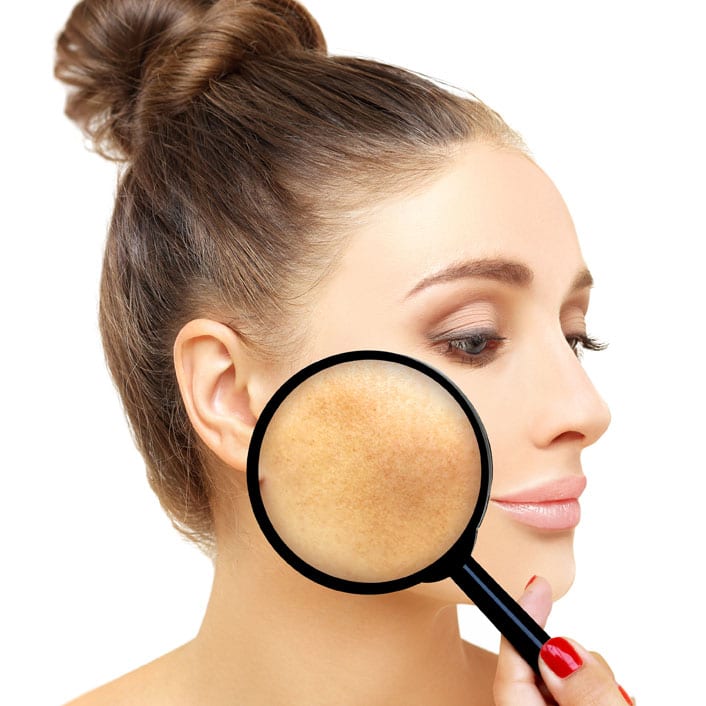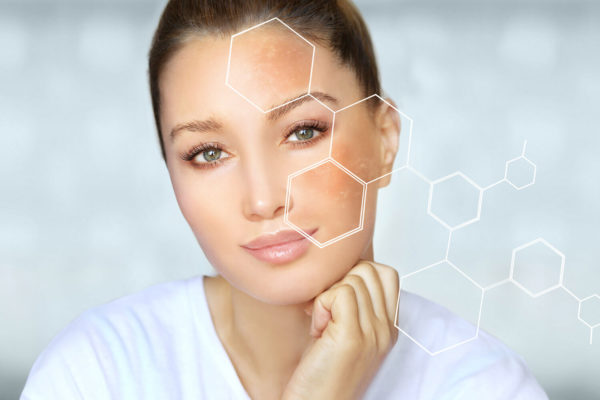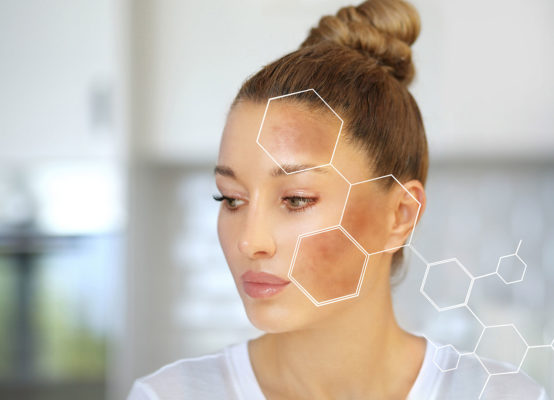A Guide to the Best Makeup and Skin Care Products for Melasma
The best products for melasma can minimize the appearance of hyperpigmentation. Melasma is a type of skin discoloration that is typically caused by hormonal changes. It may be possible to reduce the visibility of dark blotches on the face or body through skincare treatments or get temporary coverage with cosmetics. Find out more about treatments to lighten discoloration and even out your skin tone as well as color correction and full-coverage makeup for melasma.

The best products for melasma treat or cover discoloration on any part of the body. This condition tends to cause blotches to develop on the cheeks, bridge of the nose, forehead, chin and above the upper lip. Discolored patches may also appear elsewhere on the body, particularly in areas that are prone to frequent sun exposure such as the forearms, neck and shoulders. Matching marks may appear on both sides of the face or as mirror images on other parts of the body.
Exposure to sunlight intensifies melasma. Many people with this skin condition often find that discoloration lightens in the winter or with recommended use of sun protection. Topical treatments and skin care procedures can lighten melasma. You can also temporarily reduce the visibility of blotches by using face and body makeup to cover melasma.

In general, a sensitivity to changes in estrogen and progesterone triggers melanocytes to produce melanin and dump it into the lower levels of skin. While hormones are the underlying cause of most melasma, discoloration is intensified by sun exposure. Any form of visual light and infrared heat can cause blotches to form and spread. The best products for melasma lighten existing hyperpigmentation and prevent more dark spots from forming.
In addition to sunlight, blue light from screens and other visible light can worsen melasma. Infrared heat also intensifies this type of hyperpigmentation and is present in environments without direct sunlight such as warm gyms, hot yoga studios, saunas and even in home or commercial kitchens. Ultraviolet radiation and infrared heat stimulate skin cells that produce pigment that melasma causes to dump melanin into lower levels of skin. Deeper pigment deposits may be more difficult to treat with topical products.
Melasma can also coincide with other types of discoloration such as freckles, sun spots or residual signs of irritation. A patch of skin may become darker than the surrounding skin color due to acne scarring, inflammation caused by eczema or dermatitis, sun damage or a side effect of some skin care treatments. Hyperpigmentation due to these causes may be more responsive to topical ointments and skincare treatments and less likely to return with sun protection or avoidance.

A doctor or dermatologist can do tests to rule out other causes of hyperpigmentation or skin conditions. Once the condition has been confirmed, you may be prescribed the best products for melasma, such as hydroquinone, tretinoin, topical steroids, kojic acid, azelaic acid, niacinamide or Vitamin C. Pregnant women experiencing chloasma may be able to use some topical treatments, but tretinoin is not recommended for use during pregnancy.
Topical treatments for melasma are likely to be most effective for pigmentation that is not deposited deep in skin. Chemical peels, dermabrasion, microdermabrasion and other resurfacing treatments may also be helpful. If melasma involves melanin deposits deeper in skin, an aesthetician or dermatologist may recommend a galvanic or ultrasound facial or laser treatment. Intense pulsed light is not an effective way to treat melasma, as light exposure can darken discoloration.
Melasma can form on any part of the body, though it is most common on the neck, shoulders and forearms. All of these areas are commonly exposed to sun. In addition to applying sunscreen to all exposed skin, you may also want to wear clothing with a UPF rating. A garment rated UPF 50 or higher only allows about 2% of UV rays to pass through. About 20% of UV light can penetrate through a plain white t-shirt. Broad-brimmed hats and other forms of physical sun protection can prevent melasma from getting darker during spring and summer.
In addition to treatments prescribed or performed by an aesthetician or dermatologist, you may also be able to manage the appearance of melasma by applying vitamins topically. Look for skin treatments that contain Vitamin C, Vitamin E and Vitamin K. Vitamin C and E also have photoprotective properties, particularly when combined.
Makeup for melasma is the best short- and long-term solution prior to and during treatment. The best products for melasma are primers that even out skin tone, full-coverage concealer, foundation and finishing powder. Factor in the color of the patches of skin you want to conceal and select a color-correcting formula with peach, orange, red or yellow tones. Green concealers are designed to counteract redness, which is not useful for most melasma.
Makeup artists sometimes recommend matching to the darker shade for freckles or other widespread skin discoloration. This is not the case with melasma. Most melasma is dark enough that it will result in makeup that does not match the skin on your ears, neck or body. Focus on spot concealing and correcting color to achieve the look of an even skin tone.
In the morning, start by washing your face and any affected parts of your body with a cleanser formulated to even out skin tone. Apply any topical treatments described by a dermatologist in advance of sunscreen rated SPF 30. Apply a makeup primer that evens out skin tone to lay the basis for covering melasma and any other skin discoloration as well as reducing the appearance of fine lines or large pores.
Some makeup artists apply color-correcting concealers in advance of foundation. Use a product with yellow, peachy, orange or red tones depending on the color of discoloration. The shade of melasma varies depending on skin tone. You may find it helpful to have a cosmetics color matching specialist consult on the best shades of makeup to cover melasma or any other hyperpigmentation.
Full-coverage foundation is necessary to even out the appearance of most melasma, but you do not need to apply this product to your whole face. Dab, pat or tap foundation onto primed skin with fingers or a beauty sponge. Never rub or wipe face makeup over spots you are trying to cover, as these motions reduce coverage. Use concealer to hide any discoloration that is still apparent and blend with the surrounding skin. It may be helpful to use a matching concealer shade rather than a color-correcting formula at this stage.
Contouring products can be helpful for drawing attention away from melasma. You may want to use blush, bronzer or highlighter to complete the effect. Finish your makeup application with a finishing or setting powder for longer wear with less transference. The best products for melasma provide sun protection. Try pairing sunscreen with foundation, concealer or finishing powder with SPF to give areas of skin prone to darken in sunlight more physical protection.

Topical creams or ointments can be helpful for treating melasma that is not as dark or deep. The most common treatment is hydroquinone, a chemical that inhibits the enzyme involved in the production of melanin. Hydroquinone is available over-the-counter in strengths up to 2% and the best products for melasma in prescription strengths may contain up to a 4% concentration. The safety of this treatment is currently being evaluated, but these strengths have been cleared for sale.
A dermatologist may recommend the use of a cream, gel or lotion containing topical corticosteroids. Tretinoin, an acid that increases skin cell turnover, is also a common treatment. Combined treatments such as triple combination creams or dual combination therapy may be more effective than single-ingredient approaches to treating melasma. Products containing Tretinoin are not safe for pregnant women to use. Other combined creams may be safe and effective to use to treat chloasma.
Several other topical treatments are used separately or combined to treat melasma. A dermatologist may recommend products that contain azelaic acid 20%, kojic acid 2%, Cysteamine hydrochloride 5% or Flutamide 1%. Some patients may benefit from taking tranexamic acid by mouth, as this treatment may decrease melanogenesis in skin cells. Medical professionals may also recommend using any of the best products for melasma in conjunction with resurfacing treatments.
Melasma that is relatively superficial may benefit from chemical peels, dermabrasion or microdermabrasion. These methods may also be useful for enhancing the effectiveness of topical treatments for deeper pigmentation. You should always consult with a trained professional aesthetician or dermatologist about chemical skin treatments. Allergic contact dermatitis and other reactions can cause skin to become inflamed and more prone to discoloration.
Dermatological procedures such as laser treatments and galvanic or ultrasound facials may be more effective for lightening melasma in the long term. It may be necessary to repeat treatments on a monthly or more frequent basis initially followed by maintenance sessions every six months or as needed. Intense pulsed light treatments can cause melasma to darken. If you are prone to this skin condition, you may want to avoid using IPL treatment on any form of discoloration.
No matter which treatments you use, it is important to wear broad-spectrum sun protection every day and reapply every two hours during prolonged exposure. Titanium dioxide and zinc oxide are physical sun blockers found in the best products for melasma that are more effective at stopping sunlight from intensifying discoloration than chemical sunscreen.
Exposure to any form of light can worsen melasma, even less direct exposure from sitting near a window or in front of screens that emit blue light. In addition to sunscreen, you may also want to make sure any makeup for melasma you use has an SPF rating with physical sunscreen to provide more protection to parts of skin prone to discoloration. Reducing exposure to infrared heat may require other lifestyle changes. It may be necessary to practice sun avoidance for the duration of intensive treatment.
Although it may not be possible to get rid of melasma permanently, preventing patches from forming or becoming dark makes it easier to use makeup to cover melasma. If melasma persists throughout hormonal treatments or pregnancy and remains visible afterward, a combination of topical treatments and skincare procedures can be used to reduce the visibility of this discoloration on bare skin.
The hormonal instigating factor for melasma makes this type of hyperpigmentation more challenging to treat than other causes of skin discoloration. Melanin may be deposited deeper in skin and dark patches may return or worsen as long as instigating factors are present. Discoloration may naturally become lighter during winter or with daily use of recommended sun protection and disappear on its own after pregnancy or hormonal treatment.
Melasma is not a harmful skin condition. The best products for melasma can lighten or cover dark spots to promote an even skin tone and prevent skin from becoming more discolored.
Even Out Your Skin Tone With the Best Products for Melasma
Melasma is a form of skin discoloration that is often caused by [Read More...]
Your Simple Skincare Routine for Melasma
Are you wondering if you’ve adopted the right skincare routine for melasma? [Read More...]



